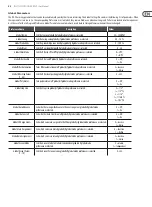
10
RHYTHM DESIGNER RD-9 User Manual
4. Overview
This overview will help you set up the RD-9 analog rhythm designer and briefly
introduce its capabilities.
4.1 Connections
The RD-9 has a ¼" (6.35 mm) mono jack output on the rear of the unit plus 10
independent voice ¼" (6.35 mm) jacks.
Note:
When the individual voice outputs are used and connected, they cut
that voice from the MAIN MONO output. This is useful for adding effects or for
external processing to individual sounds. E.G. Use the Bass Drum and Snare Drum
outputs to add compression and reverb to those voices and apply processing to
the remaining voices via the mono output.
Audio return is via the ¼" (6.35 mm) mono RETURN jack on the rear panel. This
input can be used to process an individual voice or voices via external processing
(mixer, compressor or reverb, etc.), then return the signal back into the main
output of the RD-9. Please consult the connection set-up guide for examples
(8.1).
The CLOCK IN/OUT connections use 1/8" (3.5mm) TRS jacks.
CAUTION: Do not overload the 1/8" (3.5 mm) CLOCK IN input. This jack can only
accept voltages up to a maximum of +15 V. The 3.5 mm CLOCK OUT outputs
should only be connected to inputs capable of receiving the output voltages.
Failure to follow these instructions may damage the RD-9 or external units.
4.2 Software Setup
The RD-9 is a USB Class Compliant MIDI device, and so no driver installation is
required. The RD-9 does not require any additional drivers to work with Windows
and MacOS. The Behringer SynthTool is available to program many of the features
of the RD-9.
4.3 Hardware Setup
First make all the audio and power connections to your system. Connect a DAW,
external sequencer or keyboard with MIDI output directly to the RD-9 MIDI IN
5-pin DIN type input or via MIDI over USB if desired. Apply power to the RD-9
using the supplied power adapter only. Ensure your sound system is turned
down. Turn on the RD-9 rear power switch. Use the MIDI page in the settings
function to set the RD-9 to a unique MIDI channel within your system.
4.4 Voice Section
In this section the sounds and controls are described to help you achieve the most
from the RD-9 which has 11 different sounds.
(1)
ACCENT
– This function is used to give emphasis to any voice. When
programming a step, press the step twice of the voice you wish to add a
fixed accent to, this is shown in solid red. Press again to remove the step.
Fixed accents are not affecte d by the accent control.
The ACCENT control determines the amount of emphasis given to global
accents. To add a global accent, which affects all voices on that step, press
and hold the TAP/HOLD button and press the step you want the global accent
on. This is displayed in white. Turn the level control counterclockwise (CCW)
to reduce the amount of global accent on all voices. Turn clockwise (CW) to
increase the global accent level.
Accent can also be programmed via MIDI or USB with a high velocity value,
in a DAW or via MIDI any velocity value can be used in order for crescendos
to be programmed. Sounds can be played with accent by holding the TAP/
HOLD button while pressing the voice you wish to play (this also works with
the TRIGGER button).
(2)
BASS DRUM
– This classic sound defined a generation. The LEVEL control
adjusts the level compared to the other voices. TUNE controls the pitch
envelope depth applied to the bass drum. Turning CW Raises the pitch of
the sound. ATTACK – Controls the Attack portion of the bass drum sound,
turn CW to increase the attack. DECAY controls how long the drum will ring.
Turn CW for longer tones. PITCH DEPTH adjusts how much the pitch envelope
affects the bass drum oscillator, turn CW to increase the slide of the sound.
PITCH sets the frequency of the bass drum oscillator. PITCH DEPTH and PITCH
are only active with enhanced mode on described later in this manual.
(3)
SNARE DRUM
– The SNAPPY control simulates the sound of the
snares microphone moving closer to and from the bottom drumhead. TUNE
changes the pitch of the snare. TONE Applies a filter to the voice, reducing
the high frequencies as you turn CCW. LEVEL control as the bass drum voice.
(4)
LOW TOM
– TUNING adjusts the pitch of the sound. Turn CCW for
low sounds and CCW to raise the pitch. LEVEL control is the same as the bass
drum voice.
(5)
MID TOM
– Same functions as (4) LOW TOM.
(6)
HI TOM
– Same functions as (4) LOW TOM.
(7)
RIM SHOT
– The LEVEL control adjusts the level compared to the
other voices.
(8)
CLAP
– The LEVEL control adjusts the level compared to the other voices.
(9)
CLOSED HAT
– LEVEL control as the BASS DRUM voice. TUNE controls the
frequency of the hats with ENHANCED MODE on and affect both closed and
open Hi Hat. When the closed hat is programmed on a step immediately
after an OPEN HAT, the closed hat voice cuts the OPEN HAT voice, which is a
classic drum machine trick to simulate a real hi-hat. CH DECAY Changes the
decay time of the closed hat voice. Turn CCW for shorter, CW for longer.
(1)
(2)
(3)
(4)
(5)
(6)
(8)
(7)
(9)
(10)
(12)
(11)
Summary of Contents for RD-9
Page 38: ...We Hear You ...

























